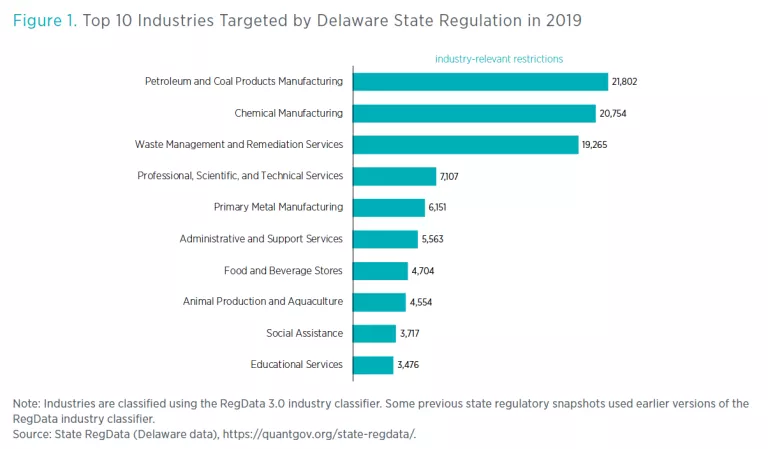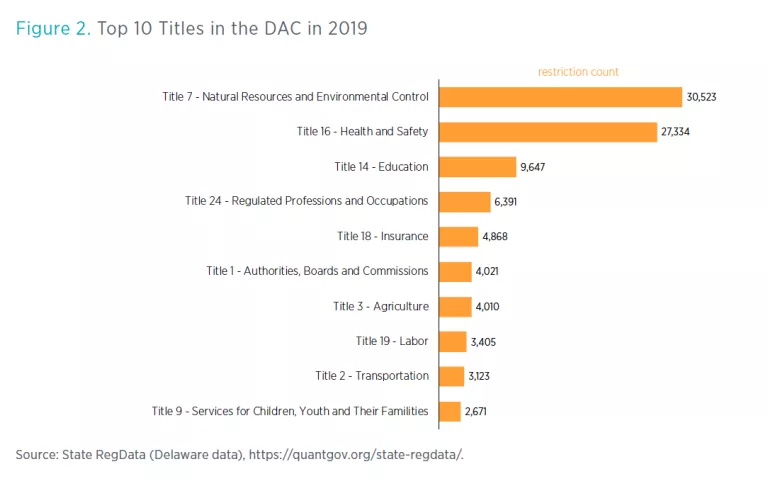- | Regulation Regulation
- | Policy Briefs Policy Briefs
- |
A Snapshot of Delaware Regulation in 2019
104,562 Restrictions, 6.7 Million Words, and 9 Weeks to Read
It would take an ordinary person almost three years to read the entire US Code of Federal Regulations(CFR), which contained nearly 104 million words in 2017.[1]The sheer size of the CFR poses a problem not just for the individuals and businesses that want to stay in compliance with the law but also for anyone interested in understanding the consequences of this massive system of rules. States also have sizable regulatory codes, which add an additional layer to the large body of federal regulation. A prime example is the online version of the 2019 Delaware Administrative Code(DAC).[2]
Researchers at the Mercatus Center at George Mason University developed State RegData, a platform for analyzing and quantifying state regulatory text.[3]State RegData captures information in minutes that would take hours, weeks, or even years to obtain by reading and counting. For example, the tool allows researchers to identify the industries that state regulation targets most by connecting text relevant to those industries with restrictive word counts. These regulatory restrictions are instances of the words and phrases shall, must, may not, prohibited, and required, and they can signify legal constraints and obligations.[4]As shown in figure 1, the three industries with the highest estimates of industry-relevant restrictions in the 2019 DAC are petroleum and coal products manufacturing, chemical manufacturing, and waste management and remediation services.
State RegData also reveals that the 2019 DAC contains 104,562 restrictions and 6.7 million words. It would take an individual about 374 hours—or more than 9 weeks—to read the entire DAC. That’s assuming the reader spends 40 hours per week reading and reads at a rate of 300 words per minute. By comparison, there are 1.09 million additional restrictions in the federal code.[5]Individuals and businesses in Delaware must navigate these different layers of restrictions to remain in compliance.

The titles of the DAC are organized by the type of regulations they contain. Figure 2 shows that title 7 of the DAC, associated with natural resources and environmental control, contains 30,523 restrictions. By this measure, this is the biggest title in the DAC. Coming in second is title 16, related to health and safety, with 27,334 restrictions.

Federal regulation tends to attract the most headlines, but it is important to remember that the nearly 104 million words and 1.09 million restrictions in the federal code significantly understate the true scope of regulation in the United States. States like Delaware write millions of additional words of regulation and hundreds of thousands of additional restrictions. State-level requirements carry the force of law to restrict individuals and businesses just as federal ones do.
Researchers are only beginning to understand the consequences of the massive and growing federal regulatory system on economic growth and well-being in the United States.[6]Meanwhile, the effects of state regulation remain largely unknown. If this snapshot of Delaware regulation in 2019 is a good indicator, then the states are also active regulators, suggesting that the full impact of regulation on society is far greater than that of federal regulation alone.
Acknowledgment
The author would like to thank Michael Kotrous for helpful research and programming assistance that contributed to this report.
[1]This assumes the person reads 300 words per minute for 40 hours per week with two weeks of vacation per year. “RegData 3.1,” QuantGov; Patrick A. McLaughlin, Oliver Sherouse, Daniel Francis, Michael Gasvoda, Jonathan Nelson, Stephen Strosko, and Tyler Richards, “RegData 3.0 User’s Guide,” accessed February 15, 2018, https://quantgov.org/regdata/users-guide/.
[2]State of Delaware, “Delaware’s Administrative Code,” accessed June 14, 2019, http://regulations.delaware.gov/AdminCode/.
[3]State RegData is part of a broader project called QuantGov, which seeks to quantify legal text. See Patrick A. McLaughlin and Oliver Sherouse, “QuantGov—A Policy Analytics Platform,” QuantGov, December 20, 2017. Data for Delaware are available at https://quantgov.org/state-regdata/.
[4]Restrictions can also occur in legal text for other purposes, such as for definitional purposes. At times, restrictions may relate to government employees rather than the private sector.
[5]“RegData 3.1”; McLaughlin et al., “RegData 3.0 User’s Guide.”
[6]See, for example, Bentley Coffey, Patrick A. McLaughlin, and Pietro Peretto, “The Cumulative Cost of Regulations” (Mercatus Working Paper, Mercatus Center at George Mason University, Arlington, VA, 2016).


